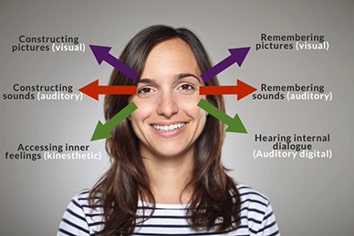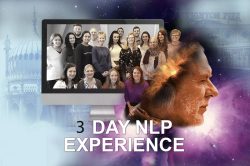
There is no doubt that one of the most fascinating and at the same time controversial aspects of what Richard Bandler and John Grinder modeled in the 1970s, was eye accessing queues. Eye Patterns.
In their work on eye patterns, they had begun to notice that there appeared to be a correlation between where people’s eyes look, to the kind of sensory language they are using. More particularly, they suggested the people’s eyes move around when they are thinking and internally processing (prior to speaking), and that you can often see a correlation between what they then say and where their eyes were before they spoke. Next time you’re having a conversation with someone, pay particular attention to what happens to their eyes when they are thinking, particularly after you asked the question. Do you see any patterns or themes?
From the work of Bandler and Grinder (and also Robert Dilts), they discovered that as people recall certain parts of information, their eyes will move to certain quadrants of their brain to access either visual, auditory, kinaesthetic or self talk. This then gives you a good idea about what that person is doing inside their mind as they try and recall information.
Grinder and Bandler identified pattern of relationship between the sensory-based language people use in general conversation, and for example, their eye movements (known as eye accessing cues).
A common (but not universal) style of processing in the West is shown in the attached chart, where eye flickers in specific directions often seem to tie into specific kinds of internal (mental) processing. NLP also suggests that that sometimes (again not universally), such processing is associated with sensory word use, so for example a person asked what they liked about the beach, may flick their eyes briefly in some characteristic direction (visual memory access, often upwards), and then also use words that describe it in a visual sense (“The sea looked lovely”, and so on). Likewise asked about a problem, someone may look in a different direction for a while (kineasthetic access, typically downwards) and then look puzzled and say “I just can’t seem to get a grip on things”. Taken together, NLP suggests such eye accessing cues are idiosyncratic and habitual for each person, and may form significant clues as to how a person is processing or representing a problem to themselves unconsciously.
Here’s a short video which will give you some idea of how eye patterns work:
This is for as you were looking at someones face:
Visual Construct Top left quadrant Visual Remembered Top right quadrant
Audio Construct Middle left quadrant Audio Remembered Middle right quadrant
K (Tactile) Bottom left quadrant Audio Internal (or AD) Bottom right quadrant
Questions to ask someone to find out what’s happening……..Watch the eye patterns!
- Visual Remembered: Think of the colour of your car. What kind of pattern is on your bedspread? Think of the last time you saw someone running. Who were the first five people you saw this morning?
- Visual Construction: Imagine an outline of yourself as you might look from six feet above us and see it turning into a city skyline. Can you imagine the top half of a toy dog on the bottom half of a green hippopotamus?
- Auditory Remembered: Can you think of one of your favourite songs? Think of the sound of clapping. How does your car’s engine sound?
- Auditory Constructed: Imagine the sound of a train’s whistle changing into the sound of pages turning. Can you hear the sound of a saxophone and the sound of your mother’s voice at the same time?
- Auditory Digital (Internal Self Talk): Take a moment and listen to the sound of your own inner voice. How do you know it is your voice? In what types of situations do you talk to yourself the most? Think of the kinds of things that you say to yourself most often.
- Kinaesthetic Remembered: (Tactile) When was the last time you felt really wet? Imagine the feelings of snow in your hands. What does a pine cone feel like? When was the last time you touched a hot cooking utensil? (Visceral/Emotional) Can you think of a time you felt satisfied about something you completed? Think of what it feels like to be exhausted. When was the last time you felt impatient?
- Kinaesthetic Construction: (Tactile) Imagine the feelings of stickiness turning into the feelings of sand shifting between your fingers. Imagine the feelings of dog’s fur turning into the feelings of soft butter. (Visceral/Emotional) Imagine the feelings of frustration turning into the feeling of being really motivated to do something. Imagine the feeling of being bored turning into feeling silly about feeling bored.
Note: – NLP does not say it is ‘always’ this way, but rather that one should check whether reliable correlations seem to exist for an individual, and if so what they are.
Common (but not universal) Western layout of eye accessing cues:
• Upwards (left/right) — Visual (V) — “I can imagine the big picture”
• Level (left/right) — Auditory (A) — “Let’s tone down the discussion”
• Down-right — Kinesthetic (K) — “to grasp a concept” or “to gather you’ve
understood.”
• Down-left Auditory internal dialogue (Ad) — talking to oneself inside
Eye movements to the left or right for many people seem to indicate if a memory was recalled or constructed. Thus remembering an actual image (Vr) is associated more with up-left, whilst imagining one’s dream home (Vc) tends (again not universally) to be more associated with up-right.
If they are looking up and to their left (see diagram), they will be remembering pictures (VR or visual remembered).
If they are looking down and to their left (your right – as you look at them) they will be accessing self talk (AD on the diagram).
If they are looking down to their right (your left as you look at them), they will be accessing feelings.
To the middle right or left they will be remembering or creating sounds (AR, audio remembered and AC, audio created).
In terms of learning and education, this can be really useful as you can begin to tell where your pupils (via their pupils), are trying to access information from and what strategies they are using to get their information. For instance, if you ask a person to spell a word, and they are looking down to the ground to their right-hand side they will be accessing feelings, so it will be no wonder that Charles would not be a very good speller. Try to spell a word by feeling it is probably the worst strategy you can imagine. Also, if the person looks to their left hand side the middle (see diagram). Then they’ll be trying to spell the word by hearing it phonologically: also, not the best strategy to use! You can’t even spell phonologically, phonologically!! Let’s try….fonologically…nope!
You can improve people’s spelling ability or learning ability by teaching them how to use the visual aspect of their brain. You’ll see the remarkable effect it will have what you have learnt how to do this sufficiently. Of course this isn’t just useful for pupils, this will also be useful to you and any conversation negotiations situations where it’s important you to know how the other person is processing their world.
From your ability to connect with rapport on the physiological basis, you also now have the added information of knowing how that person prefers to internalise their world and then projected it outwardly. If you know a person is predominantly visual (of course, you can always tell this by the words they’re using as well), you will be able to enter into their world, communicate in their way and perhaps even move them to different areas that is more appropriate for the task in hand.
If we backtrack to the anchoring section, you could also discover whether a person goes to a certain quadrant in their mind for memories about themselves and past experiences. If they keep on accessing visual remembered (see diagram) and have a bad feeling towards it, you may suggest that they start to create a new image by using visual creative element of their brains and notice that they can put their eyes up and to their right, to these to create something new, and a new way of learning.
Here is a good example of how to change a bad spelling strategy.
Pick somebody who spells particularly poorly and they are motivated to spell differently and better. Ask them for a word that they cannot possibly spell. Catherine Sprackling, head of French at a Brighton school performed this technique shortly after being trained how to use it.
What Catherine did was to take a pupil and choose a word of which he possibly could not possible spell and believed could never spell. Then she wrote that word on a piece of paper and chunked it into three parts. She used her knowledge of anchoring to make the boy feel good about the prospect of learning (you could just ask the pupil if there’s been a time when they didn’t think they could learn something and then they did). Catherine then showed the word, piece by piece (you can also make the chunks different colours to aid the visual aspects). She got him to recite each chunk of the word, whilst holding the word in his visual recall quadrant (VR). She would take the paper away each time but ask him to keep visualizing the chunk of word in his mind (watch their eye patterns to make sure they stay in visual recall). Then finally, she took away all of the chunks and asked him to spell the whole word, which he did successfully first-time. Then to the amazement of the rest of the class room, she got him to spell the word backwards with no more revision. He did it perfectly!
That’s one way of using eye patterns and others can be for selling techniques for instance.
If you are selling a product and face to face, start to be aware of if your customer is making pictures, sounds or feeling the product or service out. If you notice they are accessing feelings a lot, simply get them to TRY the product or service rather than TALKING about it too much.
If you want more information on Eye Patterns and Strategies, have a look at that link.
There’s a whole library of ways to be using knowledge on eye patterns, so see if you can get yourself onto an NLP training and get the whole experience instead of listening to more theories, you’ll be way ahead in your own field!
Eye Patterns




